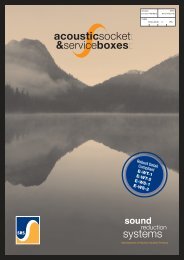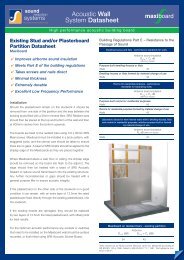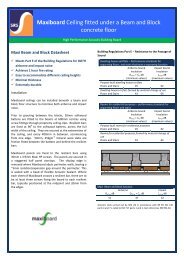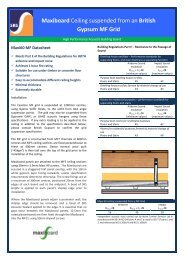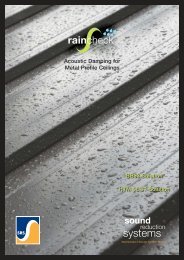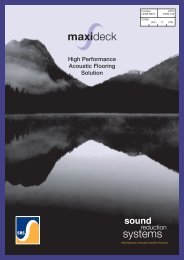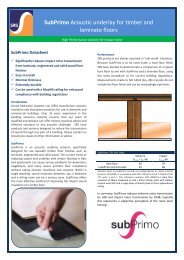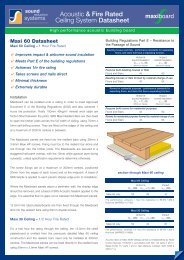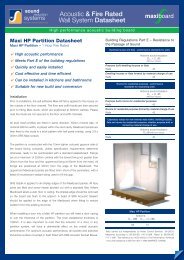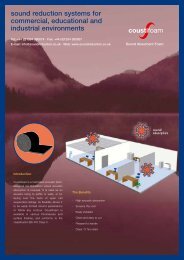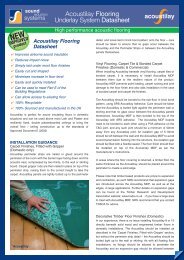Soundbar 53 Brochure - Sound Reduction Systems Ltd.
Soundbar 53 Brochure - Sound Reduction Systems Ltd.
Soundbar 53 Brochure - Sound Reduction Systems Ltd.
- No tags were found...
Create successful ePaper yourself
Turn your PDF publications into a flip-book with our unique Google optimized e-Paper software.
sound reduction systems for<br />
commercial, educational and<br />
industrial environments<br />
Tel: +44 (0)1204 380074 · Fax: +44 (0)1204 380957<br />
E-mail: info@soundreduction.co.uk · Web: www.soundreduction.co.uk<br />
soundbar<br />
Acoustic Barrier<br />
Introduction<br />
<strong><strong>Sound</strong>bar</strong> is a high performance, flexible<br />
acoustic barrier designed to reduce<br />
sound transmission through suspended<br />
ceiling voids. Installed from the soffit to<br />
the partition head, it is ideal where<br />
partitions or walls are installed to the<br />
underside of a suspended ceiling. For<br />
ease and speed of installation, it can be<br />
installed from one side by one man.<br />
<strong><strong>Sound</strong>bar</strong> can reduce room to room noise<br />
by up to <strong>53</strong>dB. It provides maximum<br />
speech privacy and protection against<br />
unwanted noise. Pleasant to handle and<br />
easily cut and shaped, it will readily form<br />
around services which pass through the<br />
barrier.<br />
<strong><strong>Sound</strong>bar</strong> is formed with a dense core<br />
bonded between two fibrous layers. The<br />
outer surface has a reinforced aluminium<br />
facing. It is supplied as a system with all<br />
accessories for installation.<br />
The Benefits<br />
· Very high room to room sound<br />
insulation<br />
· Easily installed from one side<br />
· Easily cut and shaped<br />
· Easily accommodates service<br />
penetrations<br />
· Easily jointed<br />
· Suitable for retrofit<br />
· Installation causes minimum<br />
disruption<br />
· All fixing and accessories provided<br />
Alternative Solutions<br />
<strong>Sound</strong>blocker - page 4<br />
<strong>Sound</strong>stop - page 10
soundbar<br />
Installation<br />
The <strong><strong>Sound</strong>bar</strong> system provides all the<br />
accessories required to form a properly<br />
sealed acoustic curtain within the ceiling<br />
void. It is fixed to the soffit and walls by<br />
means of a steel angle. The angle has a<br />
foam sealing gasket which compresses<br />
against the soffit. The downward leg of<br />
the angle presents a self adhesive<br />
surface that temporarily holds the<br />
<strong><strong>Sound</strong>bar</strong> in place, while a plain angle is<br />
used to clamp the material.<br />
It hangs as a curtain to the partition or<br />
wall head where it is secured by the<br />
same means.<br />
The top fixing angle is securely fixed to<br />
the soffit fully compressing the gasket<br />
seal. The <strong><strong>Sound</strong>bar</strong> curtain is fixed to<br />
the downward leg. The leg has a self<br />
adhesive surface which holds the curtain<br />
for ease of installation. It is secured by a<br />
slotted clamping angle which is fixed<br />
with tec screws at a maximum of<br />
200mm centres. (There must be a fixing<br />
at a maximum of 50mm from the edge of<br />
the curtain.) At the base a clamping<br />
angle is fixed through to the partition<br />
head. The curtain is secured to this by a<br />
clamping angle, cut to fit and<br />
compressed against the ceiling grid with<br />
all joints treated with a cover strip.<br />
Large voids<br />
Where a void exceeds 1200mm in<br />
depth, supporting channel section is<br />
required to be installed at 575mm<br />
centres. The <strong><strong>Sound</strong>bar</strong> is then fixed to<br />
this and the cover strip is applied to both<br />
vertical and horizontal joints.<br />
PLAN SECTION<br />
The vertical joints are butted together<br />
and covered with a self adhesive cover<br />
strip. This makes for easy and quick<br />
installation.<br />
Offcuts can be re-used as part of the<br />
curtain or to make good gaps caused<br />
by accommodating services or other<br />
penetrations.<br />
CROSS SECTION<br />
<strong><strong>Sound</strong>bar</strong> is fixed from the soffit to the<br />
partition head. The angle can be fixed<br />
through the ceiling tile or direct onto the<br />
partition head.<br />
· page 15
soundbar<br />
Penetrations<br />
We suggest various methods to<br />
accommodate penetrations but site<br />
conditions will determine the best<br />
approach to adopt. In all situations, holes<br />
and gaps must be fully covered and all cut<br />
pieces should be securely fixed.<br />
<strong><strong>Sound</strong>bar</strong> should be cut as close as<br />
possible to the penetrating section and<br />
any holes or gaps may be sealed with<br />
cover strips, which are easy cut and<br />
shaped as appropriate.<br />
Cover strips cut and overlapped to form<br />
around a penetration.<br />
Cover strips are cut to cover the hole,<br />
these are applied by building up and<br />
overlapping to form a good seal.<br />
<strong><strong>Sound</strong>bar</strong><br />
Acoustic Barrier Kit<br />
A collar can be formed out of cover<br />
strips to make a seal. They are cut to<br />
25mm wide and coiled around the<br />
penetrating section to fill any gap<br />
between the hole and the section.<br />
<strong><strong>Sound</strong>bar</strong> flexible acoustic barrier.<br />
Where a single pipe or duct passes<br />
through the curtain a star cut can be<br />
made to the same diameter as the<br />
section. A further cut is made from this<br />
to the curtain edge or base.<br />
Fixing Angle with sealing gasket.<br />
Pre-drilled Clamping Angle.<br />
<strong><strong>Sound</strong>bar</strong> is then formed around the<br />
section, and a cover strip is fixed over the<br />
cut, the cut being secured at the edge.<br />
Where a number of services pass<br />
through close together, a square hole<br />
can be cut, covering the combined area<br />
of the penetrations. A cut is made from<br />
this to the bottom edge and the curtain<br />
is formed around the penetrations.<br />
page 16 ·
soundbar<br />
Hex head tec Screw.<br />
Self Adhesive cover strips for sealing<br />
joints and gaps.<br />
Specifications<br />
Size 1150 x 1150mm x 15mm<br />
<strong><strong>Sound</strong>bar</strong> <strong>53</strong><br />
Fire Rating BS476 Part 6 Class 0<br />
BS476 Part 7 Class 1<br />
Weight 9 kgm 2<br />
Cutting By long bladed trimming knife.<br />
Cover Strips<br />
Size 1150 x 50 x 9mm<br />
Fixing Angle<br />
Size 3000 x 25 x 25<br />
Slotted Clamping Angle<br />
Size 3000 x 25 x 25<br />
SRS Angles are 0.7mm gauge steel, pre drilled at<br />
200mm centres.<br />
Hex head tec screw<br />
25 x 5.5mm - 5 / 16 AF<br />
Handling/Storage<br />
Must be laid flat. Must be kept dry.<br />
<strong>53</strong>dB<br />
Room to room (D ncw )<br />
(dB)<br />
70<br />
60<br />
50<br />
40<br />
30<br />
20<br />
10<br />
0<br />
Acoustic performance<br />
As tested in accordance with BSEN<br />
20140.9 1994 (Rated according to<br />
BS5821 Part 1, 1984) Room to Room<br />
normalised weighted sound level<br />
difference (D ncw <strong>53</strong>dB). Test carried out<br />
4.11.98 test no c/98/5L/7479/1 <strong>Sound</strong><br />
Research Laboratories <strong>Ltd</strong>, Holbrook<br />
House Sudbury Suffolk.<br />
· page 17



